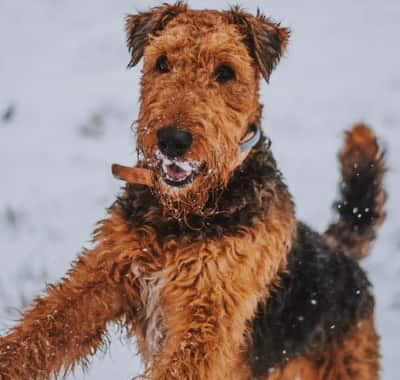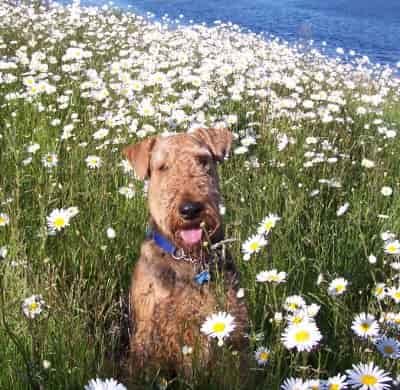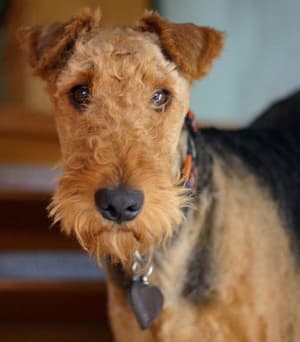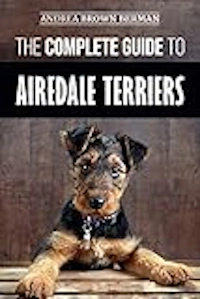Airedale Dogs
King Of Terriers And King of Many Hearts!
Airedale dogs originated in the British Isles in the Valley of the Aire during the Industrial Revolution of the 19th century. They were developed from crossing more than one existing breed which included the Otterhound and the now extinct English Black and Tan Terrier.
What resulted was a larger terrier of great versatility, tenacity and toughness and limitless abilities. Sportsmen were quick to put his noteworthy swimming skills to work in the rivers to kill otters and water rats, and on land to hunt wolves and wild boar.
On another front, farms and factories had a vermin problem and the 'Dale being equally adept and astoundingly quick as rat catchers, was the fix.
We're not done yet - Airedales also excel in setting, retrieving and flushing, and have hunted with great agility the Fox, Badger, Weasel, and Foumart. In other countries, they have assisted in big game hunting.
The First World War saw the Airedale's abilities called upon to serve in the Armed Forces as messengers, ratters, supply carriers, sentries, and guard dogs.
Over the years, Airedale dogs have been enjoyed by celebrities and former Presidents including Woodrow Wilson, Calvin Coolidge and Warren G.Harding as well as actors John Wayne and Clint Eastwood.
Mr. Harding's dog, Laddie Boy, was given birthday parties with his dog friends and is commemorated by a statue at the Smithsonian Institution.
He also gained the distinction of
receiving the most press coverage of any White House dog, with stories
about him running in the news almost daily.
Airedales crossed the pond to America in the 1880s, and were subsequently recognized by the American Kennel Club (AKC) in 1888. Since that time, they have been honored as Best In Show at least four times for their appearances at the prestigious Westminster Kennel Club dog show.
The 'Dale is intelligent, playful, quick-witted and while he can be stubborn, he is also intensely loyal and protective and makes a devoted family member.
As watchdogs, Airedales are fearless, though not aggressive, always alert to any unusual activity and rest assured they will make sure you know about it too!
Admirers of the breed seem to be equally as loyal as their dogs, rarely straying to other breeds and usually find them so much fun that one is not enough. Three or four running around is quite the norm.
One endearing feature of the breed is that they remain very much like a
puppy throughout their lifetime. Full of fun and mischief.
As for getting along with other dogs, just see how gentle the Airedale
is with a Norwich Terrier puppy in this video and judge for yourself:
Characteristics Of Airedale Dogs
As members of the family, 'Dales fit in really well because they are very adaptable and extremely resilient - no wimps here.
You'll find them
intelligent, lively, eager to please and given to playful, clownish
behavior as well. They love being part of the family and thrive on
attention so don't get this dog breed if you want them to spend their
lives in the back yard.
Oh, they will adapt to an outdoor situation, but like most terrier
breeds, if human interaction is limited, they will find outlets for
their boredom that you won't find amusing!
Terriers have inherited strong digging traits so don't be surprised if you find them re-landscaping your back yard for a bit of stimulation when they are bored or not being given enough exercise or companionship.
When training Airedales the best approach is to keep the sessions short with the main focus being on almost game-like creativity and variety or your Dale will lose interest and start looking for something more exciting to do.
Airedale dogs are very intelligent thinkers and respond enthusiastically if you give them positive feedback and let them know when they are pleasing you. Harshness will not get the job done, but plenty of patience and affection will.
Appearance
Although the Airedale is the largest dog in the Terrier group of dogs, compared to dog
breeds in general, they would be considered to be in the medium-large range.
You may have heard references to a larger sized Airedale known as the
Oorang. This is not an AKC recognized line, but a strain associated with the Oorang Kennel Company of the 1920's.
Walter Lingo, the owner of the kennels was dedicated to developing a strong all-pupose working farm dog and to this end, he acquired many Airedales from far and wide. His breeding program was considered quite unconventional and created a fair amount of controversy at the time.
Although serious fanciers of the Airedale have stuck with the AKC standard intended by its original developers, some kennels still offer the larger Oorang to this day.
So here's what to look for in a traditional Airedale Terrier:
Height: 22-24 inches
Weight: 44-70 lbs.
Color variations: Tan with either a black saddle or one that is referred to as grizzled - a mix of black, grey and white
Grooming Airedales
Airedale dogs have a hard, dense and wiry outer coat, with a second soft undercoat.
Daily brushing is needed to prevent mats and tangles from forming which tend to accumulate around the muzzle and armpits.
The coat is waterproof and sheds little, meaning that the dead hair has a
tendency to build up in the coat and needs to be regularly removed.
Periodically, Airedale terriers will
"blow" their coat all at once in a heavy shedding.
If you acquire an Airedale you are planning to show, the coat must be hand stripped which is a method of pulling out the loose/dead hair. It is done with a serrated edged knife and is quite time consuming. A professional groomer can do this, or you can learn the technique yourself if you have the time plus a patient dog!
There are two great tools for home grooming double-coated dogs that,
used together, make short work of removing the accumulation of dead hair
in the undercoat.
The first one is Mars Stainless Steel Coat King Pet Stripper which emulates professional hand stripping, takes less time and does a great job with thick undercoats. The other tool, the
FURminator is great for maintenance of shedding.
For everyday touch-up this brush is one I keep on hand: Hertzko Self Cleaning Slicker Brush along with a good comb.
Airedale Terrier Health
Airedale dogs are generally a healthy and quite hardy breed. That said, some will encounter a few health problems, but usually minor ones.
Here are a few to be aware of that may affect your dog:
Hip Dysplasia: This is an inherited issue involving the hip joint that results in pain, muscle loss and lameness. It’s a degenerative disease, but there are many treatments and therapies available. Hip dysplasia can affect any dog, but it’s more common in larger breeds.
When considering a puppy, always ask your breeder about what tests have been done on the parents' hips.
Hypothyroidism: Hypothyroidism is an endocrine disease where the body does not make enough thyroid hormone. Symptoms often include weight gain, hair loss, and lethargy.
The condition is fairly easy to treat. Typically it is diagnosed with a blood test and treated with daily medications. A symptom might be itchy skin or a type of allergy - diet or other.
Dilated Cardiomyopathy: (DCM): An inherited disease that affects the heart muscle. In dogs with DCM, their heart muscle is weakened and cannot pump blood effectively. Over time, this leads to heart enlargement (dilation) and can result in complications like abnormal heart rhythms (arrhythmia), difficulty exercising and heart failure. Screenings should be done annually. Several drugs are used to treat the symptoms and help prolong life.
Bloat: Otherwise known as gastric dilatation-volvulus (GDV), is a life-threatening condition affecting large breed dogs where the stomach fills up with food or air and twists. The main symptoms include non-productive retching (trying to vomit but no vomit is produced) and abdominal distension. If you notice these symptoms, please take your dog to the vet immediately. Typically, emergency surgery is needed.
Health Tests recommended by the National Breed Club:
- Hip Evaluation
- Cardiac Exam
- Ophthalmologist Evaluation
- Kidney Disease Screening (CHIC)
Regular hygiene of the 'Dale should include: Keeping ears clean and dry, clipping toe nails as needed, brushing teeth daily to prevent dental problems and keeping foot pads clear of debris and the hair trimmed.
With the benefit of a high quality diet, sufficient exercise and regular veterinarian check-ups, pet parents can expect to enjoy their 'Dale for up to 14 years or more.
Activity Level of Airedale Terriers
Airedale dogs, while enjoying a high amount of activity, are usually quiet and low key snugglers inside the home. I don't mean on your lap - just give them a nice bed.
They have a tendency to play in bursts of high energy, then after wearing themselves out, have a good long snooze!
Plenty of play plus long walks on a daily basis are necessary for a fully grown Dale and will result in a very contented dog.
Ideal Living Space
The amount of space isn't so important as the need to get
significant exercise. An apartment will do, but this breed also enjoys
romping around outside, so a yard or play area is a real plus.
He's also very curious (nosy) to see what's going on around him!
The one caveat is that outside space must be securely fenced because
Dales are both fearless and protective and have a strong prey drive!
Secure fencing also protects pets from outside threats such as coyotes, skunks and other dogs.
Airedale Dogs
With Children?
Airedale dogs get along very well with children and are great pets for them. They are patient and gentle and love a game - several in fact!
However, it bears mentioning that Airedale Terriers are very strong dogs and really get involved in the excitement of play which could be overwhelming for toddlers. In this case, raising them from a puppy with very young ones would be best.
Whatever the case, it is always in the best interest of children that they be
supervised when playing with a dog - no matter what the breed's
reputation.
Companions For Seniors?
If sufficient exercise can be provided and the Airedale grooming needs met, this breed makes a very loving and protective companion for senior or less active families.
Sufficient exercise cannot be overlooked so it needs to be worked out before acquiring one of these delightful dogs.
Find Airedale Dogs to Buy Or Rescue
The first step in finding Airedale dogs is locating a reputable breeder because the more professional breeders are concerned with the quality and health of their puppies. Hobby breeders are a good place to start because they are dedicated to the breed and are not breeding for a profit.
On the other hand, back yard breeders, along with pet shops and puppy mills, should be avoided because they are not concerned with upholding any standard - only about the breed's popularity and making sales.
Not all breeders are ethical or responsible. Your breeder should belong to the Airedale Terrier Club of America, a local Airedale Terrier Club or a local all-breed club. This indicates a stronger love for what they do. Look for a breeder who answers your questions and gives results of tests willingly as further assurance of a reputable place to trust
Here are some places to begin your search: The American Kennel Club maintains a list of breeders pledged to uphold AKC-endorsed responsible breeding practices: https://www.marketplace.akc.org/
The Airedale Club of America has a breeder referral list where you can find a breeder state by state.
For rescue, adoption and fostering Airedale Terrier Rescue and Adoption has dogs in 12 Midwest states and the province of Ontario.
Book Recommendation
Before You Go...
If you like the content of this page, as well as others on my site, please give it some love by clicking on the heart in the lower right hand corner. This helps me keep providing enjoyable and useful content.
Thank you.
More to Explore
- Home ›
- Dog Breeds ›
- Airedale Terrier

Image resource: Angela Montillon [CC BY-SA]






